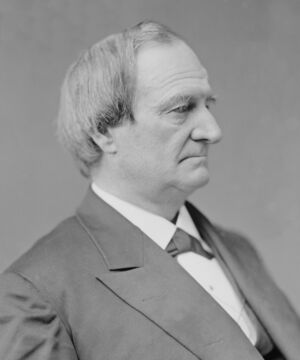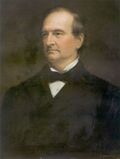Alphonso Taft
(politician) | |
|---|---|
 | |
| Born | 5 November 1810 Townshend, VT, USA |
| Died | 21 May 1891 (Age 80) San Diego, CA, USA |
| Nationality | US |
| Member of | Skull and Bones |
Alphonso Taft (November 5, 1810 – May 21, 1891) was an American jurist, diplomat, politician, Attorney General and Secretary of War under President Ulysses S. Grant. He was also the founder of the Taft political dynasty, and father of President and Chief Justice William Howard Taft.
As Secretary of War, Taft reformed the War Department by allowing commanders at Indian forts to choose who could start and run post traderships. While serving as Attorney General, he strongly held that African Americans must not be denied the right to vote through intimidation and violence.[1] Attorney General Taft coauthored a bill to Congress, signed into law by President Grant, that created the Elections Commission that settled the controversial Hayes-Tilden presidential election.
Taft was appointed as minister to Austria-Hungary by Chester A. Arthur in 1882. He served until July 4, 1884, and was then transferred by President Arthur to Minister of Russia, and he served in St. Petersburg until August 1885. Taft had a reputation for serving political office with integrity and character.
Contents
Early life
Alphonso Taft was born in Townshend, Vermont, the only child of Peter Rawson Taft of the powerful Taft family and Sylvia Howard, on November 5, 1810. While the Taft family was of substance and education, they were not considered wealthy.[2] Taft attended local schools until the age of sixteen. He then taught school to earn money to attend Amherst Academy. During his time at Amherst, he and Samuel Colt stole a cannon belonging to General Ebenezer Mattoon and shot it at their school. Taft entered Yale College in 1829 and he graduated four years later in 1833. Taft helped create the secret society known as Skull and Bones in 1832 with William Huntington Russell.
Upon graduation, again to earn money, Taft was an instructor at Ellington, Connecticut, from 1835 to 1837. He subsequently studied law at the Yale Law School and was admitted to the Connecticut bar in 1838. While studying law Taft held a tutorship at Yale. Taft had no desire to remain in New England, and he stated to his father Peter in a letter written on July 22, 1837, that Vermont was a "noble state to emigrate from." Taft did not want to practice law in New York because he believed people were under the corrupting influence of wealth.[3] In 1839 Taft migrated to Cincinnati where he was a member of the Cincinnati City Council, and became one of the most influential citizens of Ohio. He was a member of the boards of trustees of the University of Cincinnati, Antioch College, and Yale College.[4]
Marriages, family, estate
Alphonso Taft was married twice. In 1841 he married Fanny Phelps (born 1823), daughter of Judge Charles Phelps, and they had five children, three of whom died in infancy:
- Charles Phelps Taft (December 21, 1843 – December 31, 1929)
- Peter Rawson Taft II (May 10, 1846 – June 3, 1889)
- Mary Taft (November 24, 1848 – November 29, 1848)
- Alphonso Taft (May 12, 1850 – March 2, 1851)
- Alphonso Taft (December 22, 1851 – June 22, 1852)
Fanny Taft died on June 2, 1852, a few days before her last child's death. On December 26, 1853, Taft married Louisa Maria (née Torrey) (born 1827), his fourth cousin twice removed, and the daughter of Samuel Davenport Torrey, of Millbury, Massachusetts. They also had five children, one of whom died in infancy:[5]
- Samuel Davenport Taft (February 1855 – April 8, 1856)
- William Howard Taft (September 15, 1857 – March 8, 1930)
- Henry Waters Taft (May 27, 1859 – August 11, 1945)
- Horace Dutton Taft (December 28, 1861 – January 28, 1943)
- Frances Louise "Fanny" Taft (July 18, 1865 – January 4, 1950)
The estate of Alphonso Taft and his family, in Mount Auburn, one mile north of downtown Cincinnati, has been restored to its original appearance. It is open to the public and is now called the William Howard Taft National Historic Site.[6]
Cincinnati attorney and career
Alphonso Taft formed a law firm with Thomas Marshall Key and William M. Dickson in April 1854.[7] He was a delegate to the Republican National Convention in 1856, and also that year made an unsuccessful run for the United States House of Representatives against George H. Pendleton. Taft supported the Union during the Civil War. He was a judge of the Superior Court of Cincinnati from 1866 to 1872 when he resigned to practice law with two of his sons.[8] He was the first president of the Cincinnati Bar Association, serving in 1872.
In the court case Board of Education of Cincinnati vs. Minor (1872), Taft dissented against the decision made by the Superior Court of Cincinnati regarding the reading the Bible in public schools.[9] Taft asserted that the school board was within its rights to stop the practice of reading the Bible in public schools, arguing that religious liberty demands that "The government is neutral, and, while protecting all [religious sects], it prefers none, and it disparages none."[10][11] Taft's dissent helped to sway the Ohio Supreme Court, and they ruled in favor of the school board, overturning the Superior Court ruling. In his discourse, Taft specifically referenced Jewish groups opposed to the reading of the Bible in public schools. As taxpayers, Taft argued, Jews also had the right to take advantage of a public secular education.[12] In addition, religion was a matter of the home and protected by the Bill of Rights. To suggest that the Bill of Rights only reflects Protestant values was inappropriate, according to Taft, as religious liberty was given to all religious denominations and Christianity "is not to be regarded as sectarian under our constitution."
Many believe that Taft's opinion was the cause of much opposition to him, and contributed to his 1875 loss of the Republican nomination for Governor of Ohio to Rutherford B. Hayes. However, the opinion that defeated his nomination was unanimously affirmed by the Supreme Court of Ohio. The independence of Taft's opinion commanded widespread respect, a sentiment freely expressed when President Ulysses S. Grant in March 1876 made him Secretary of War and three months later Attorney General of the United States.
Taft was elected a member of the American Antiquarian Society in October 1876.[13]
Secretary of War
When President Grant's Secretary of War William W. Belknap resigned in 1876 over receiving profit money from the Fort Sill Indian tradership, Grant needed to find a replacement. Initially, Grant had Secretary George M. Robeson run both the War Department and the Navy Department. [14] Robeson, however, had told Grant that the two Cabinet positions were difficult to manage by one person.[14] Grant then asked Taft to be Secretary of War. After consultation, Taft, who was of good reputation, accepted the position and was confirmed handily by the Senate without objection.
Taft made a series of reforms to the War department to restore its reputation and entanglements caused by Belknap's humiliating resignation.[15] Taft reversed the War Department policy by having commanders at U.S. military forts in the West to choose who would run post traderships. Additionally, Taft ordered his Bureau and Commandant Department heads to lower their military expenditures. The old ways of letting things go under Belknap and Robeson were over under Taft and he was well received by the press.
U.S. Attorney General
Grant appointed Taft U.S. Attorney General after he had made a Cabinet shift by appointing Edwards Pierrepont Minister to England. Taft was replaced by J. Donald Cameron as Secretary of War. In October 1876, after the highly contested Hayes-Tilden presidential election, Attorney General Taft supported President Grant's use of the military in South Carolina and Mississippi to suppress violence against African Americans in the South. Taft gave a lengthy speech in New York outlining the atrocities committed by Southerners against blacks in the South. In order to prevent the U.S. from fighting a second civil war, Taft supported a bill, signed into law by Grant, that peacefully settled the 1876 election with an Electoral Commission.
Bid for office
Taft was again an unsuccessful candidate for Governor of Ohio in 1879, this time against Charles Foster.
U.S. Minister
Taft was appointed by President Chester A. Arthur as U.S. Minister to Austria-Hungary (1882–1884) and to Imperial Russia (1884–1885).
Family dynasty
Taft was a member of the Taft family political dynasty. His son, William Howard Taft, was the 27th President of the United States and the 10th Chief Justice of the United States, and was a member of Yale's Skull and Bones like his founder father; another son, Charles Phelps Taft, supported the founding of Wolf's Head Society at Yale; both his grandson and great-grandson, Robert A. Taft I (also Skull and Bones) and Robert Taft Jr., were U.S. Senators; his great-great-grandson, Robert A. Taft II, was the Governor of Ohio from 1999 until 2007. William Howard Taft III was ambassador to Ireland; William Howard Taft IV worked in several Republican administrations, most recently that of George W. Bush.
References
- ↑ New York Times October 26, 1876
- ↑ https://archive.org/stream/dictionaryofamer18amer#page/264/mode/2up
- ↑ Pringle 1936, p. 264.
- ↑ Religion and the Law in America: An Encyclopedia of Personal Belief and Public Policy. Vol. 1. (Santa Barbara, CA: ABC-CLIO, 2007), 149.
- ↑ Ancestry of William Howard Taft, Library of Congress (Archive.org)
- ↑ https://web.archive.org/web/20100828122911/http://www.nps.gov/wiho/
- ↑ https://quod.lib.umich.edu/cgi/f/findaid/findaid-idx?cc=clementsead;c=clementsead;idno=umich-wcl-M-2051dic;didno=umich-wcl-M-2051dic;view=text
- ↑ Wilson, J. G.; Fiske, J., eds. (1889). "Taft, Alphonso" . Appletons' Cyclopædia of American Biography. New York: D. Appleton.
- ↑ Mark A. Noll, A Documentary History of Religion in America since 1877, 3 ed. (Grand Rapids: William B. Eerdmans Publishing Company, 2003), 49.
- ↑ Mark A. Noll, A Documentary History of Religion in America since 1877, 3 ed. (Grand Rapids: Wm. B. Eerdmans Publishing Company, 2003), 52.
- ↑ https://www.mtsu.edu/first-amendment/article/660/board-of-education-of-the-city-of-cincinnati-v-minor
- ↑ Mark A. Noll, A Documentary History of Religion in America since 1877, 3 ed. (Grand Rapids: Wm. B. Eerdmans Publishing Company, 2003), 51.
- ↑ American Antiquarian Society Members Directory
- ↑ a b Leonard 1920, pp. 159-160.
- ↑ https://archive.org/stream/lifeofalphonsota00leon#page/n9/mode/2up p. 159.
